Steam Page || Developer’s Site || Playthrough Part 2
Top-down action rogue-likes (or rogue-lites or roguelike-likes or whatever you want to call them at this point) have been ridiculously common in the world of indie game development ever since The Binding of Isaac became popular and, to be perfectly honest, I’ve never been particularly fond of this subgenre as a whole, but Monolith stands out in some very substantial ways. Infused with the soul of a bullet hell shmup, Monolith introduces a whole new layer of carefully handcrafted bullet-dodging action to the formula while fixing many of this subgenre’s shortcoming, making this not only a game which is designed to be replayed multiple times, but one which you’ll actually want to reply again and again.
There’s a giant monolith, you’re a ship, and you want to reach the lowest level of this mysterious structure. Sure, there’s a bit more to the story than that, but Monolith is an indie game where the the gameplay is far and away the most important element. Controller support is included, though I’d say that mouse and keyboard controls are the way to go this time around. A very brief tutorial at the start walks you through the basic controls and progression, both of which should feel familiar to most players. WASD moves, you use your mouse to aim, holding down the left mouse button attacks, the right mouse button dashes, and left shift lets you use a bomb if you have one (you start each run with two and can get up to six by default). You’ll be using the dash quite often, especially during boss fights, though it doesn’t grant you any invincibility frames unless you find an upgrade for it so it might take a run or two before you can use it effectively. As for bombs, they are largely used for defensive purposes because enemies don’t take much damage from them, but they do clear the screen of bullets on top of knocking enemies back a bit to let you escape if you’re cornered.
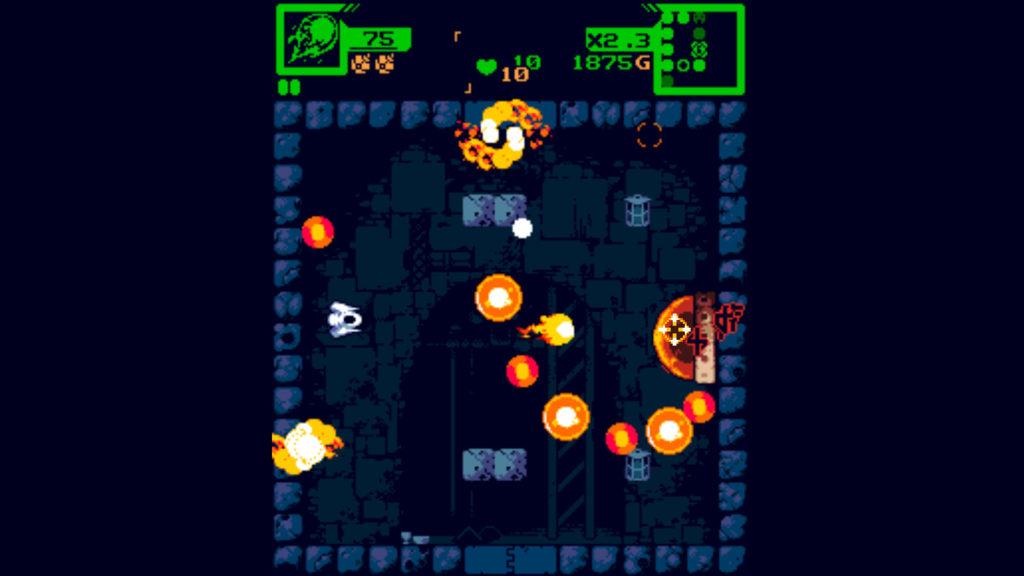
I’ve been focusing quite a bit on the controls here because they really do contribute a lot towards making Monolith fun to play. The speed and smoothness with which your ship flies around and, to a lesser degree, the ease with which you can freely aim your attacks are common elements in shmups, yet too often in dungeon crawling rogue-likes players are forced to deal with deliberately rigid aiming or slow and/or stiff movement. The controls simply feel good and, by extension, every time you take damage it feels like it’s due to having backed yourself into a corner or not dodging in time as opposed to, say, being utterly overwhelmed by attacks which you stand little chance of fully avoiding if you didn’t stumble across decent upgrades along the way.
Let’s take a look at Monolith‘s approach to both progression and procedural generation because the two go hand in hand. The game is divided into a series of square, single-screen rooms spread out across five floors, plus a sixth floor which can be unlocked after defeating the ‘final’ boss and performing some tasks. The goal of each floor is to reach the boss room and defeat the boss to unlock the way leading deeper into the monolith. However, you must break a container in the boss room to start the boss fight itself and this container in turn can only be broken once you have defeated every miniboss on the floor. There are three different potential bosses for each of the first four floors (the bosses are always the same for floors five and six) and the number of minibosses for each floor remains the same on each run (ex: there is only ever one miniboss on the first floor). Unlike the bosses, most minibosses can appear on any given floor, a few don’t have a chance to appear until the later floors, but there are multiple room layouts per floor for each of these minibosses and they have a few variations on their attack patterns so even if you fight the same miniboss multiple times in a single run it’s rarely the exact same fight.
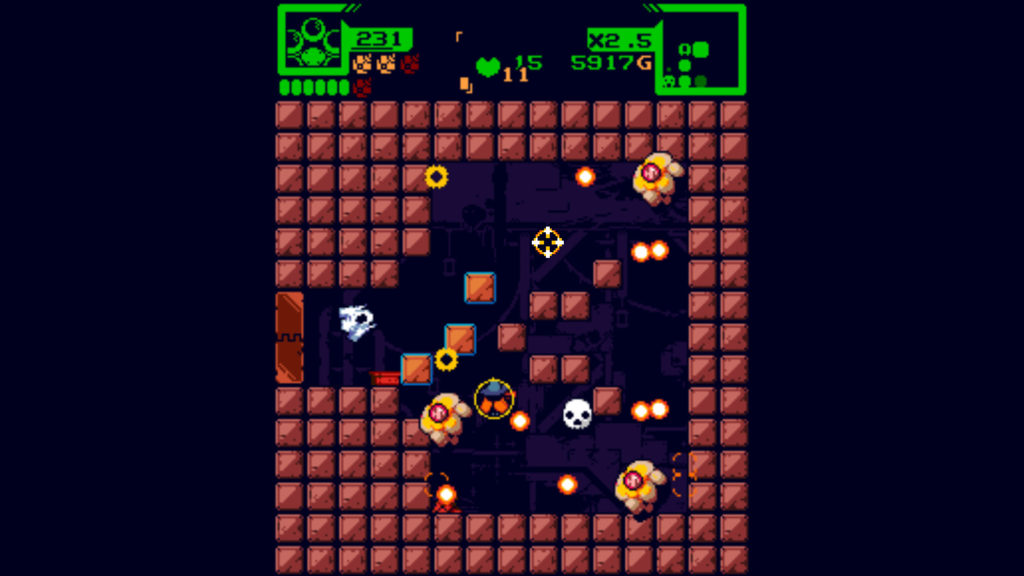
Perhaps the most important thing to mention about Monolith is that procedural generation only applies to the layout of each floor and not to each room. Every single room in the game is, as far as I can tell, 100% handcrafted and each of these rooms is tied to a specific floor. On the one hand, this means you’re inevitably going to come across old rooms in new runs and, in rare cases, you might even find two identical copies of a room on a floor within a single run. On the other hand, each room feels unique, every room is balanced with a specific point in the game in mind, and you don’t have the common procedural generation issue of seeing the same bland bits and pieces stitched together in slightly different, equally uninteresting ways. Plus, there are dozens upon dozens of potential rooms for each floor so it’s definitely going to take you quite a few runs before you see every potential room a floor has to offer and even then you can never entirely be sure you’ve seen everything. If I had to choose between Monolith‘s approach of mixing together random, handcrafted rooms in a randomized layout where you might run the risk of seeing the same room more than once in a single run or a more ‘pure’ procedurally generated experience where you get millions of technically unique rooms by randomly stitching together a few dozen potential components in slightly different ways, I’d take the former in the blink of an eye every time.
The layout of each floor may be randomized, but there are a few consistent elements along with some very, very helpful navigational decisions. In addition to having a fixed number of miniboss rooms on each floor, you are guaranteed to have exactly one room where you can get one or more weapons, exactly one room where you can choose between three random, permanent upgrades (permanent for the run anyway), and at least one shop. Most shops have three items for sale, though you can also run into a gambling shop where you pay to roll a die for a chance at a nice prize, a shrine which usually gives you a massive boost to your current bombs or ammo at the cost of reducing the maximum amount you can have, a more expensive shop which offers five items, and/or a shop where you buy items at the cost of your maximum health. Every floor also has a secret room which can vary in usefulness and can only be found by using a bomb anywhere in an adjacent room. The last type of room is the treasure room which, like the secret room, varies quite a bit in terms of reward, but not every floor is guaranteed to have a treasure room. Furthermore, you need a key to enter the treasure room, which is either gained from clearing out a random room in the floor, from choosing to take it instead of a weapon in the weapon room, or in a few other ways. This mix of guaranteed room counts and potential rooms means players who want to conserve health and beeline only for the most essential rooms on each floor can do so, but those who choose to fully explore every floor are likewise rewarded for taking risks with more money and a chance to obtain powerful rewards.
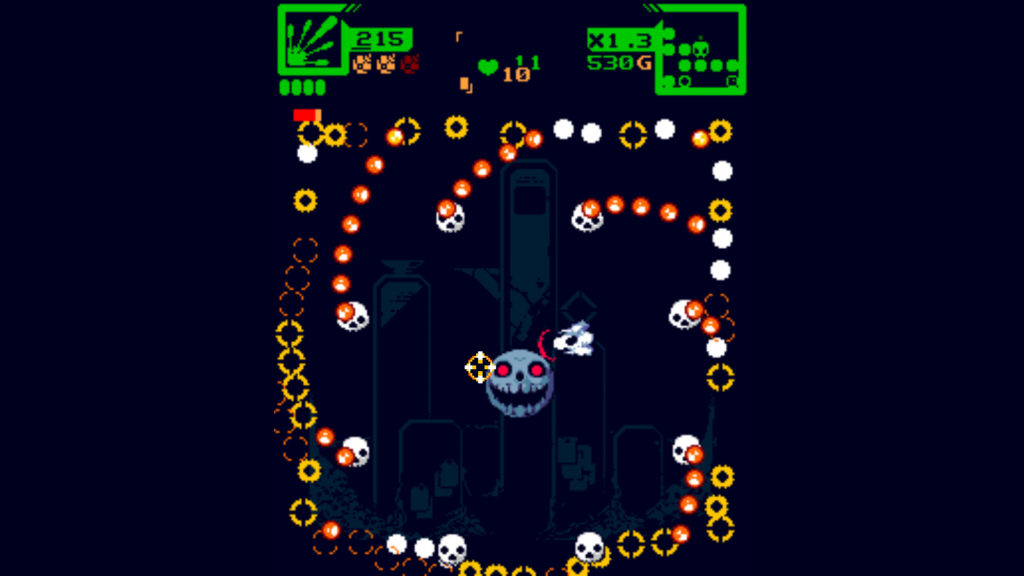
There are two navigational features here which I would love to see in more games. First, you can press Tab to open the floor map and clicking on any room you’ve already been to instantly teleports you to it. It’s a small, simple feature which, over the course of multiple runs, will save you literally hours of time which would otherwise have been spent flying through empty rooms. Secondly, the map fills in as you explore, but adjacent rooms are always marked on the map in advance. Most rooms are just represented by blank squares, but every special room has its own symbol – miniboss rooms are circles, upgrade rooms are crosses, all shops are exclamation points, and so on. This helps to make exploration a lot more enjoyable because it lets you pick your path much more efficiently. You can choose to visit the weapon room and/or the upgrade room on a floor without fear of accidentally stumbling across a miniboss or you can try going a room or two down separate paths to quickly scout out a decent chunk of the floor’s layout. The only issue with this system is that the miniboss circles and the upgrade crosses look similar enough on the minimap that they are difficult to tell apart without using Tab to bring up the main map. Otherwise, these are two excellent, basic quality of life features which are surprisingly absent from most other games.
Upgrades in Monolith are divided pretty evenly between permanent ones and temporary ones and this decision works in the game’s favor. A common problem for rogue-likes is they will be filled to the brim with dozens, if not hundreds, of potential, permanent upgrades players can come across and this sounds great on paper, but realistically it’s a nightmare to balance; just which items and in which quantities are players even assumed to have by the end? Within Monolith, the only permanent upgrades are passive ones. You’ll pick up or purchase a few upgrades which boost your base damage or maximum ammo by 5% or 10% each and you can likewise increase your maximum health either by finding specific upgrade items or by picking up a total of four points worth of healing while already at full. Other than these upgrades, you’ll only ever get a maximum of five permanent upgrades, one from the upgrade room on each of the first five floors. Furthermore, these permanent upgrades don’t alter your weapon and instead are still of a more passive nature, such as giving you a 33% discount in shops, turning your dash into a teleport, or making enemies take a little time to notice you when you enter a room.
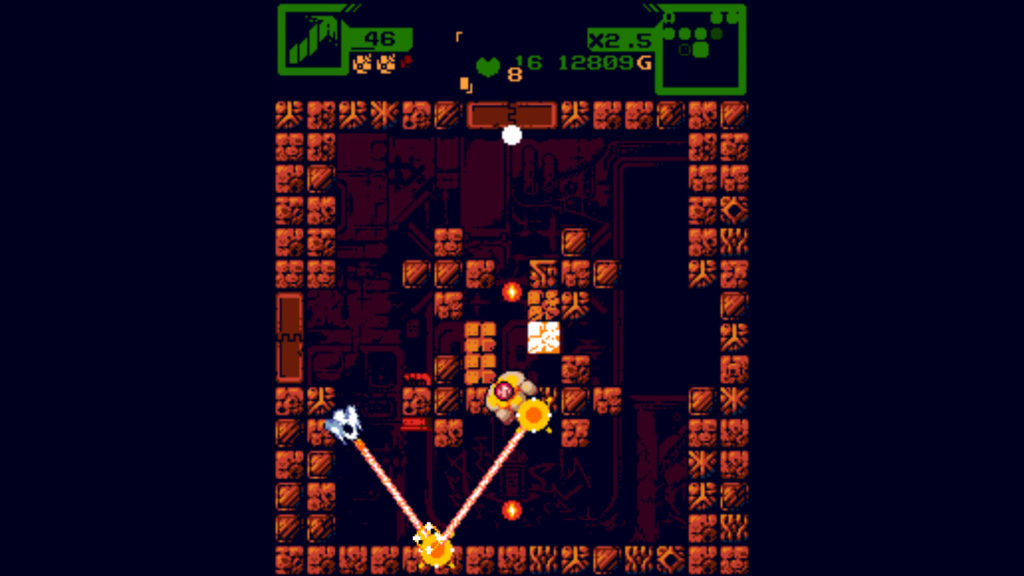
You can only ever have one weapon at a time and every weapon uses up ammo. You get a specific amount of ammo each time you pick up a new weapon with faster, weaker weapons granting hundreds more ammo than strong, single-shot weapons and you’ll immediately switch back to your default weapon if you run out of ammo; picking up ammo when you have your default gun or while you’re already at max ammo will give a slight percentage boost to your maximum. There are only seven weapons in the game, two of which need to be unlocked, but each of these weapons can be found with anywhere from two to four modifiers on it. For example, the fireball weapon normally shoots a single, large fireball forward periodically, but with modifiers it might instead send out a burst of small, homing fireballs which all explode into even more bullets when they hit an enemy.
The laser might split into more lasers, the revolver which needs to reload after six shots might get a damage boost to its final shot, the close-range sword might swing faster when you’re hitting enemies, the charge shot can send out lightning to hit anything nearby while you’re holding on to it at full charge, and so on. One of my personal favorite combinations to come across is to get the razor weapon, which normally creates spinning razors around you that you send out towards enemies one at a time like boomerangs, and have instant recall plus homing for a rapid barrage which only becomes even better if it also has the passive which sends out every blade simultaneously. Your default rapid-fire weapon also isn’t entirely terrible, I actually ended up using it to defeat the true final boss, though it’s definitely on the weak side if you haven’t found any damage upgrades and coming across a more limited version of it with modifiers is almost inevitably better. Of the weapons, the sword didn’t really fit with my playstyle and the charge shot honestly just felt too weak regardless of which passives were attached to it, but I used all of the other ones in their myriad forms constantly.
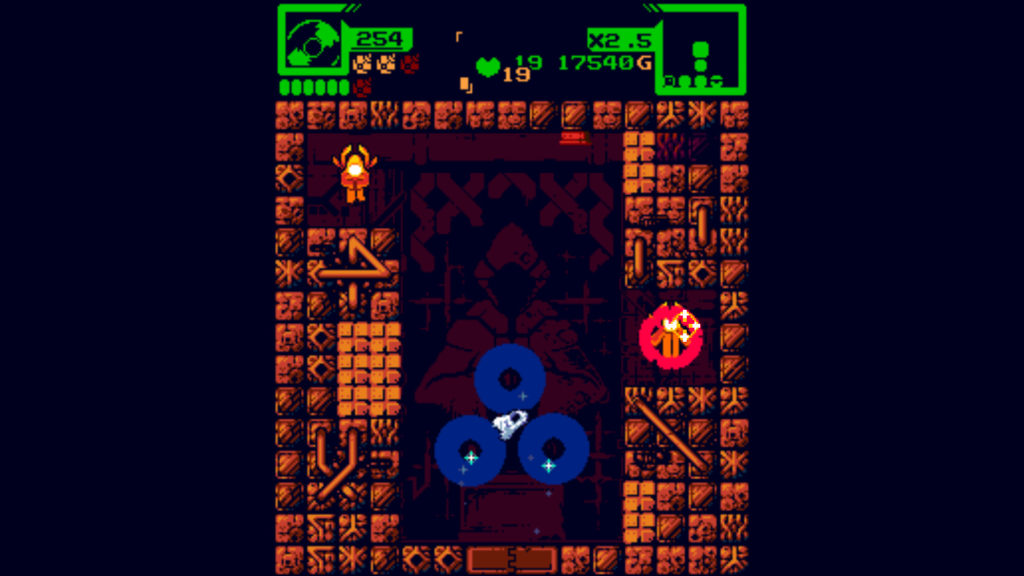
Tying weaponry to ammo was decidedly a risky decision and it’s one that paid off more than any other part of the upgrade system. There are a few reasons why this works well. First, it means the player is never too weak nor completely unstoppable; picking up a new gun instantly destroys your current gun (if you have one) and even the rarest, strongest guns in the game only have four modifiers at most. Secondly, there are incentives in play both for trying to hold on to a good gun and for switching weapons. Every time you pick up a new weapon while already equipped with something other than your default gun you get debris (money) and you are healed for one point of health.
If there’s something nice in a store on the current floor or if you just really need some health, swapping to a slightly worse weapon can be worthwhile, especially if you’ve taken the passive upgrade which boosts the amount of debris received and doubles the healing value. Alternately, if you find a really good gun the extra firepower might allow you to get through the game without taking much damage in the first place. Minibosses also factor into this system because they will drop a healing heart if you’re injured or a 100% ammo refill if you’re at full health. In other words, if you play really well and stagger out your ammo refills you can potentially hold on to a nice weapon for the entire game, but swapping weapons can help you if you’ve taken some damage and makes it less likely that you’ll run out of ammo.
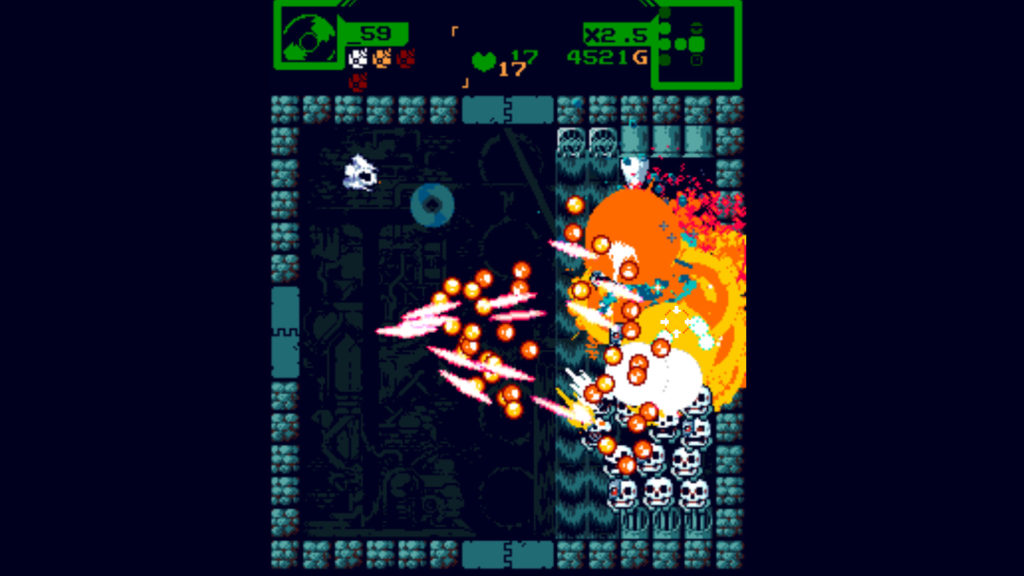
In terms of difficulty, Monolith is actually a bit on the easy side of things. The sixth floor in general is tough and the fifth floor’s boss is no pushover, but I can otherwise recall only one attempt in which I died prior to the default final boss fight. This is in part due to your default health being ten, a high number for a rogue-like and an even higher one for a shmup. You can eventually unlock modes which cap your health at three points or one in exchange for a massive default damage boost, but everything else remains the same. The fairly generous supply of healing items to find along the way from enemies and shops also helps to ensure that players will likely make it through at least the first three floors before being defeated. Ultimately, I think the slightly low difficulty up until the end is a point in the game’s favor due to the particular genre mashup this game represents. Monolith is definitely easy (though by no means trivial) by bullet hell shmup standards, but the challenges it presents players with are very different from those found in most action rogue-likes so players who are drawn to it primarily for its dungeon crawling and RPG elements are likely to find it more challenging.
The enemy, boss, and area design is fantastic here. Ghosts swarm at you, mages drop icicles down from the ceiling, fish jump out of the water to bite you, and more. There’s a ton of variety between the enemy types and most basic types of enemies in turn come in two or three variants. Enemies work well together and it never feels like they’ve been mindlessly tossed into a room because the room layouts often take full advantage of their occupants’ abilities. Enemy designs are simplistic and often abstract enough to resemble those of NES games, particularly The Guardian Legend, yet the aesthetics are decidedly more modern in detail. The game only takes itself half-seriously and this serves to give many of the enemies small, effective bits of personality. The ghost swarms are far and away the most charming enemies of them all as the ghosts randomly wear various hats and masks, but many of the bosses are cool looking, with my favorite probably being the Daemon, a giant green cyber-skeleton which floats over a ruined computer. As for the area design, each floor has a unique appearance which factors into the hazards most commonly found in its rooms. For example, the third floor is very aquatic and has a few rooms which are entirely underwater, which has a slightly affect on bullets and movement, and rooms where waterfalls will push your ship around while the fifth floor deep inside the monolith is filled with dangerous hanging wires which can electrify your ship.
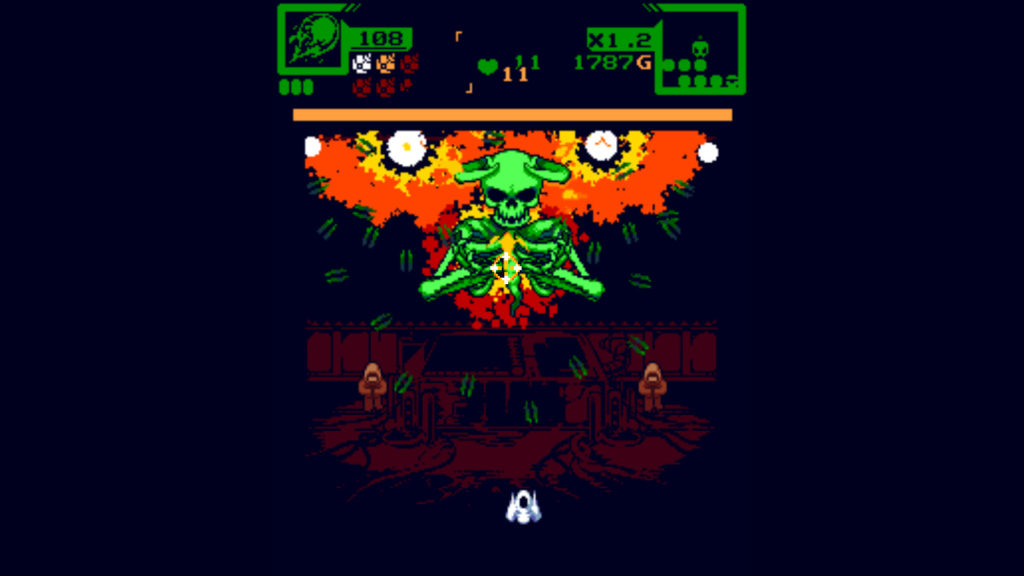
Monolith does have a few issues, but they are all rather minor. The first issue involves bombs. Specifically, you can unlock a few different types of bombs which have a chance of appearing within the dungeon on top of the standard ones, but you can’t shift around the order of the bombs you’re carrying. In other words, the order in which your bombs get used is entirely dependent upon the order in which you find them so you can’t just use your normal bombs for fighting off normal enemies and hunting for secret rooms while saving your special bombs for bosses, which is rather unfortunate if you use up a special bomb to find a secret room only to have the big prize be a copy of the very bomb you just used.
The other issue is perhaps the only common rogue-like issue which Monolith fails to avoid. Namely, you can’t toggle off items once they’re unlocked. In this game, you unlock the potential to get new items from delving deeper into the monolith and then you use debris in the hub to permanently buy them from a giant cat-like creature named Kleines. Once you buy an upgrade it can start appearing in the dungeon itself, which is great for stuff like the special bombs, but sometimes the upgrade ends up getting in the way. For example, the sword isn’t a bad weapon, but it simply doesn’t fit my playstyle regardless of its modifiers so I always avoid it, which means I paid to unlock something which just gets in the way and takes up a weapon spawn location which would have otherwise been something else. A simple option to toggle off the chance for unlocked upgrades to appear would have been useful, though the lack of one is little more than a mild annoyance.

Monolith is an all-around wonderful game. The controls are smooth and responsive, its creative approach to upgrades allows the difficulty to remain balanced regardless of your playstyle and luck, and this sense of balance is carried over to the game as a whole with just the right mix of handcrafted content and procedural generation to make for a game with plenty of replay value where every attempt at revealing the monolith’s secrets is as highly satisfying as the last.